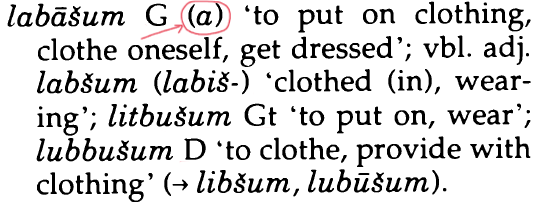L2.4: The G Preterite
Contents
L2.4: The G Preterite#
The preterite denotes an action that from the point of view of the speaker occurres or has occurred at a single point in time, also known as punctual. Therefore it is translated as simple past tense.
Important
Pattern: Prefix + R₁R₂vR₃ (+ suffix)
Personal Affixes#
To denote person, gender and number personal prefixes and sufixes are added to the root
G-Stem |
Example |
|
|---|---|---|
3s.c. |
i- |
iprus |
2s.m. |
ta-, |
taprus |
2s.f. |
ta-[root]-ī |
taprusī |
1s.c. |
a- |
aprus |
3pl.m. |
i-[root]-ū |
iprusū |
3pl.f. |
i-[root]-ā |
iprusā |
2pl.c. |
ta-[root]-ā |
taprusā |
1pl.c. |
ni- |
niprus |
Don’t panic! 😱
You don’t have to learn new personal affixes for every stem. The G-Stem personal affixes are used in G, Gt, Gtn, N, Nt, Ntn stems in all tenses. Only the root pattern changes. The stems D, Dt, Dtn, Š, ŠT, Štn have all the same personal affixes and the imperative has its own prefixes. That means you only have to lear 3 types of personal affixes. 😌.
Theme Vowel#
The vowel in the preterite pattern R₁R₂vR₃ is a short one. In case of parāsu it is u as in iprus. This is called theme vowel and is unpredictable. Therefore it has to be learned for each root. There
There are three theme vowels a, i and u:
Theme vowel a#
ṣabātum |
Translation |
|
|---|---|---|
3s.c. |
iṣbat |
she/he/it seized |
2s.m. |
taṣbat |
you (ms) seized |
2s.f. |
taṣbatī |
you (fs) seized |
1s.c. |
aṣbat |
I seized |
3pl.m. |
iṣbatū |
They (m) seized |
3pl.f. |
iṣbatā |
They (f) seized |
2pl.c. |
taṣbatā |
You (pl) seized |
1pl.c. |
niṣbat |
we seized |
Theme vowel i#
šarāqum |
Translation |
|
|---|---|---|
3s.c. |
išriq |
she/he/it stole |
2s.m. |
tašriq |
you (ms) stole |
2s.f. |
tašriqī |
you (fs) stole |
1s.c. |
ašriq |
I stole |
3pl.m. |
išriqū |
They (m) stole |
3pl.f. |
išriqā |
They (f) stole |
2pl.c. |
tašriqā |
You (pl) stole |
1pl.c. |
nišriq |
we stole |
Theme vowel u#
šakānum |
Translation |
|
|---|---|---|
3s.c. |
iškun |
she/he/it placed |
2s.m. |
taškun |
you (ms) placed |
2s.f. |
taškunī |
you (fs) placed |
1s.c. |
aškun |
I placed |
3pl.m. |
iškunū |
They (m) placed |
3pl.f. |
iškunī |
They (f) placed |
2pl.c. |
taškunā |
You (pl) placed |
1pl.c. |
niškun |
we placed |
Entry in a Dictionary
In this picture you can see that the theme vowel (a) is placed right after the infinitive of the G-stem.

The independent personal pronouns can be used with verbs for emphasis or for subject with different persons:
Usage |
Example |
Translation |
|---|---|---|
Emphasis |
atta tašriq |
It was you (ms) who stole |
Many subjects |
anāku u atta niṣbat |
You and I (we) seized |
Note
In this case the independent personal pronoun stands at the beginning of the sentence and not at the end like in the the verbless sentences.
